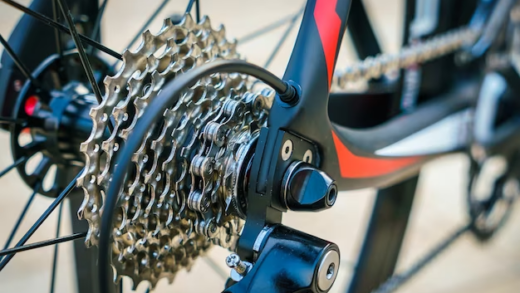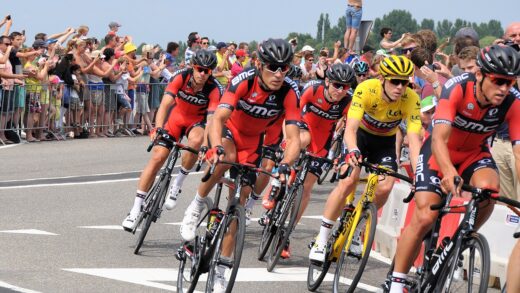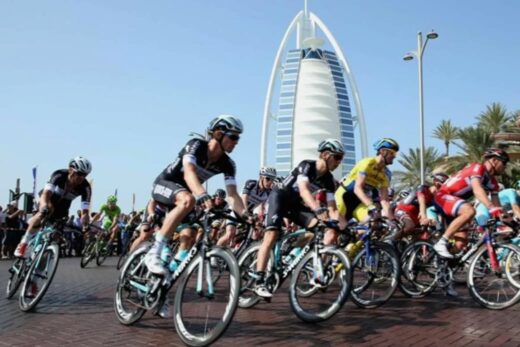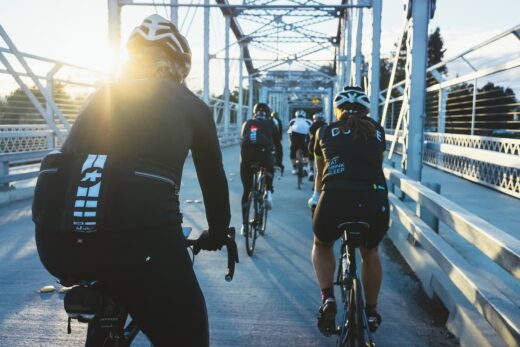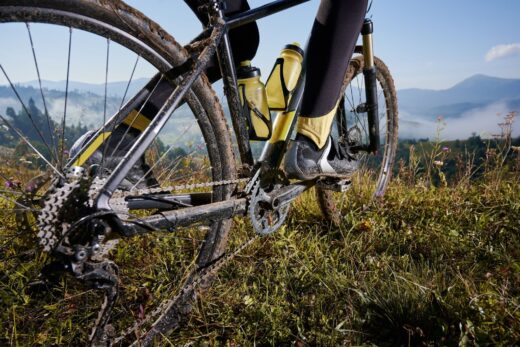Mountain bike
Mountain bike – a bicycle designed for off-road riding (although it does not exclude the opposite), and as a consequence, has a special design that differs from road, track and road (city) bicycles. Also “mountain bike” – the collective name of the sports disciplines associated with the use of a mountain bike.
Features of mountain bikes
Characteristic features of a mountain bike:
A sturdy frame with large dirt clearances.
Wide tires with off-road or combined tread pattern.
Sturdy wheels with rims usually 559 mm (26″), 584 mm (27.5″) or 622 mm (29″) in diameter (on nainers).
As a rule, the presence of suspension of the front or both wheels, with a stroke of 80 mm or more.
Hardtail – a bike with a shock-absorbing fork and rigid rear-wheel suspension.
Dual Suspension – A bicycle with soft suspension on both wheels.
Rigid – a bicycle with rigid suspension on both wheels.
Generally, the transmission has an external gearshift. The transmission has a large capacity, with up to half of the gears being downshifts.
Predominantly disc brakes. Vibrakes are found on lower-middle level models or in older bikes.
Straight handlebars or handlebars with a slight rise (Riser).
Weight of mountain bikes ranges from 7 kg (top carbon models) to 18 kg (downhill or freeride bike) depending on the discipline.
Obsolete rim brakes are now almost completely replaced by disc brakes: mechanical (with the transfer of force through a cable) or hydraulic (with a hydraulic line filled with brake fluid).
For a long time, there were 2 wheel standards for mountain biking: 24 and 26 inches. Also in 2010-2014 there were 2 more new standards 650B (27.5 inches) and 29 inches (so called “nainers”). 24 inches almost disappeared from use, remaining only for freestyle and teenage bikes.
The price of such a factory bicycle ranges from $ 100-200 (entry level) to $ 1000-10 000 and more (the level of the athlete-professional), which clearly demonstrates how different materials, quality and design of parts and manufacturing techniques are used to create a bicycle of this or that level.
Applications of Mountain Bicycles
Mountain bikes are definitely good for riding on dirt roads, off-road, as well as on snowy roads. Also, the high strength of the wheels and frames provides a relatively trouble-free ride on rough roads with a backpack weighing up to 25 kg.
Often mountain bikes (usually general purpose models) are purchased as all-purpose bikes for city, highway and dirt riding. There is some truth in this application, but bikes of the respective types are much better suited for riding on paved roads:
On the highway, a mountain bike is likely to lose out in speed to a road bike, but its suspension will require more attention.
In the city, a mountain bike is unlikely to be noticeably faster than a sitibike or commuter, and will require more maintenance.
The use of mountain bikes in cycling is unjustified for asphalt hiking, especially with small loads (up to 15 kg): in this case, a hybrid or touring would be more suitable.
Nevertheless, if any significant part of the trip is on dirt, a mountain bike is a sensible choice.
What is a two-paddle bike?
Dual-suspension bicycles are one of the least common types of bikes in the suspension classification. The most popular in Russia are hardtails (bikes with only front shock absorbers), and the most popular all over the world are rigids – bikes without shock absorbers.
Bipods were created for extreme conditions when you can not allow the loss of traction of both wheels, which is provided by the additional shock absorber. These models have always been very expensive and created a reputation for high quality and “cool” bikes, so in recent years there are more and more budget models that do not meet the requirements of sports riding, but please the customers with their bright appearance.
The construction of a two-pedal
As already mentioned, a double suspension bike – a design with two shock absorbers, ie, to the standard front fork is added rear shock absorber, which compensates for roughness and increases the comfort of the rider. Adding such an element to the frame seriously complicates the entire design of the bike and its weight, in addition, due to the piece and variety of specific conditions of use.
Recently, there have appeared solutions specifically for comfort and design – the so-called soft-tails, bicycles with a short stroke of the rear shock absorber and its simplified design. It seems that this is the consolidating division into “professional” bikes with two suspensions and “mass”, recreational models. The main orientation is the mountain riding style.
The models we are considering differ from the hardail in a very serious way:
a completely redesigned frame.
frequently modified system design.
Lack of additional accessories, such as a trunk, chain stabilizer. It is very rare to find “city” fenders.
Types of suspensions
Let’s take a closer look at what rear-wheel shock absorbers can be, and how the frame design changes for them.
Cantilever
The very first design, which appeared, de facto, the same time as the first mountain bike – in the 80s. Extremely simple design and low price are compensated by a little less reliability than other types, and a small stroke – the degree of freedom is frankly small.
At the heart of this connection is a pendulum, attached to the frame on one axis and connected to the shock absorber. This design is monotonous and partially limited to profile patents. Perhaps because of them and possible litigation, as well as because of limited refinement, there was a logical development of this design – a multilever system.
Multilever
The main design at the moment, best suited for mass consumption. Can not say that it is stable. Each manufacturer seeks to invent something new, both in search of a new design, and in an attempt to escape the patent restrictions of competitors.
In this design, the wheel is connected to the frame through a set of joints and levers, the de facto standard has become a combination of four pieces. The system is not simple and, accordingly, has a serious weight and cost. High demands on manufacturing technology lead to the fact that the durability of such a design leaves much to be desired on almost all models.
Triangle
Also quite an old design with a high cost. In it, the entire driveline is enclosed in the rear swingarm, i.e. it forms a cushioned triangle. The main difference is less load on the chain and sprockets, which is compensated by higher requirements to the shock absorber and its durability. In addition, such a system is quite heavy and requires serious maintenance at all times.
Inexpensive models
It is worth writing separately about cheap models. Manufacturers write about various methods of saving: steel instead of aluminum frame, more weight, which is compensated by a low price.
Reviews from experts are rarely unanimous: you should never buy cheap two-pods.
When choosing a two-paddle or single-paddle bike for the same price, if that price is under $1,000, you should choose a hardtail.
A two-suspension has a lot of critical points that you just can’t skimp on:
Quality of the shock absorber – the work of the shock absorber is constant, and the load is high – here the requirements are even higher than for the front fork, because the accepted force is higher.
Hinge joints – the load on the frame goes on different vectors, and if you save on joints, they very quickly come loose, destroying everything connected with them: the levers, the shock absorber, and the transmission.
Transmission – the chain, sprockets, and derailleurs are put under extra stress with constant changes in position and angles, which leads to rapid wear.
Frame construction – most are men’s “triangles”, but there is a women’s version, which has even higher requirements to the quality of materials.
Brakes – most two-pods are equipped with v-brakes and disc brakes, they have to be equipped specifically for downhill or freeride.
In sum, the set of demanding materials and quality elements dramatically increase the cost of small-to-decent models, so when buying a two-pods should be guided at $ 1,500 – $ 2,000.
Pros and cons
After the introduction, let’s briefly review the conclusions from the studied features that a two-paddle bike has, its pros and cons.
Pros:
The handling in off-road conditions;
stability of the bike in all conditions, including asphalt;
bright appearance;
economy of strength to overcome obstacles;
rider comfort and reduced stress on the joints from vibration.
Cons:
high cost;
the high weight of the bike;
short-lived design and the need for frequent maintenance;
damping of pedaling energy (low efficiency);
the complexity of the choice.
In sum, we can say that the two-pod is still a product for sporty use in downhill and other disciplines, where it reveals all its advantages. For everyday use such models should be used only by very rich riders, the rest should wait for a few years before the final development of softtails class.
Choosing a 2-pod
If it came to the choice of a two-suspension bike, then you should choose the best brand. These include Specialized, Scott, Cube, Cannondale and a few other brands.
In the budget range should consider the firm Giant, which collects all the best from the “older” brands, implementing everything in a simplified form.
Choosing a two-saddle
What to choose?
What should you learn about the selected bike? First, the direction and the appropriate layout. Many make two-pod bikes specifically for certain tasks: DH (Downhill), XC (Cross Country), FR (Freeride).
What parameter is important? You should pay attention to:
suspension design;
the layout of the driveline (chain, sprockets, derailleurs);
the material of the frame and suspension arms;
the total weight.
Once again, it should be recalled: when choosing a bicycle of this type is forbidden to save money. The result can be not only bad, but frankly harmful. For example, inexpensive frames can simply break on the next bump, which can lead to serious injury. Separately, you should pay attention to accessories – disc brakes are equipped only with top two-pods, and if you choose such a bike, you know why you need it.
Conclusion
Two-paddle bikes are actively gaining popularity, but are not yet available enough, and in the budget segment have serious disadvantages. These are models for professionals who know what they are looking for and use bikes in very rough conditions. For relaxed riding and in search of comfort, high-quality models of other layouts are more suitable.
Nevertheless, two-pods are improving, divided into several directions and are becoming more and more accessible to the broad masses of riders, which can not fail to please. They don’t have complicated transmissions or disc brakes, but they’re great for soft riding.
Now you can already find softtail models, not as expensive and complex as sport bikes, and folding two-paddle bike, the prototype of which was presented last year by Canadian manufacturers.
